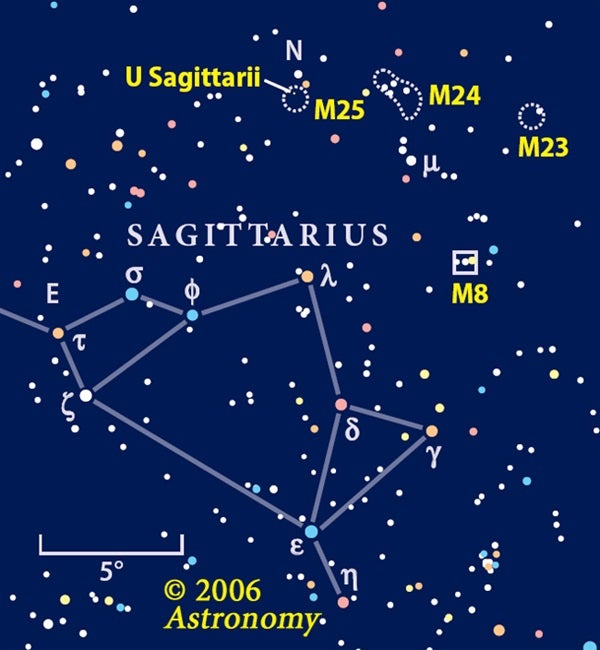This month, let’s follow the Milky Way’s gentle stream southward toward its center in the constellation of Sagittarius the Archer, as we did last August (“I’m a little teapot …”). Back then, we focused on the Lagoon Nebula (M8, or NGC 6523), the Trifid Nebula (M20, or NGC 6514), and the nearby open star cluster M21 (NGC 6531). All three fit easily into the same binocular field and are worth visiting this month if you haven’t done so already. Look for them just to the north of the spout of the Sagittarius “teapot” asterism.
Okay, let’s pick up where we left off a year ago. From M8, binocular-hop to the northeast — that is, above and a little to the left — to the star Mu (μ) Sagittarii. Continue in the same direction an equal distance to the rich star-strewn field known as M24. You’ll know you’re in the right place when you see a small, kite-shape pattern of stars in the middle of the action.
M24 is one of the most unusual members of French astronomer Charles Messier’s (1730–1817) catalog. Rather than being considered a separate star cluster, nebula, or galaxy, M24 marks a large clearing in the opaque dust that litters the Milky Way’s plane. Known as the Sagittarius Star Cloud, M24 lets us peer inward about 10,000 to 16,000 light-years along the Sagittarius spiral arm of our galaxy. Messier’s own description of a “large nebulosity in which there are many stars of different magnitudes” describes the binocular view of M24 perfectly. M24 measures about 1.5° wide.
The second star cluster here lies an equal distance to the east, or left, of M24. Through binoculars, M25 (IC 4725) should reveal four or five individual stars poking through a dim haze. One of those is a golden Cepheid variable star known as U Sagittarii. I enjoy watching U Sagittarii do its thing through binoculars. The star fluctuates between 6th and 7th magnitude every 6.74 days. Look for it to the east-northeast of the cluster’s center.
Once you’ve seen these targets, do as I do, and sit back and scan the area with your binoculars. Star-trolling, as I call it, is a wonderful way to spend a warm August night. Describing the area in his classic book Astronomy with an Opera-Glass (1888), Garrett Serviss advised readers to “look carefully all around this region, and you will perceive that the old gods, who traveled this road [the Milky Way was sometimes called the pathway of the gods], trod upon golden sands.” Along the way, you’re bound to bump into a few unexpected surprises. I’ve highlighted some of them on Astronomy.com this month, so be sure to stop by and compare notes.










